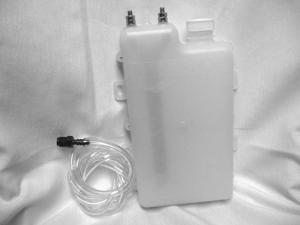"Next Generation Hydrogen Generator"
 ✖  |
Andy Herold says there are millions of engines on farms that could benefit from his compact HydroStar hydrogen generator. “Customers tell me they can’t believe the boost in horsepower the cuts in fuel usage they see after installing the HydroStar,” says Herold.
One thing that has become clear, he notes, is that the system doesn’t always work on newer vehicles (2000 and later) that have computer-controlled engine control systems. The problem is that the computer adapts to the change in fuel mix so you might decrease fuel usage initially, and then the fuel savings go away.
“I tell people with late model vehicles that there’s only about a 50 percent chance of it working,” says Herold. “However, there are people working on this problem. I bought a high performance chicp for my 2003 Dodge 1500 and the HydroStar unit now works good on it.”
Herold designed his unit to be compact, measuring only 5 in. wide by 7 1/2 in. long and 2 1/2 in. thick. All tubing and wiring needed is included in each kit. On larger engines you can hook two or more units together.
Herold says the best results with his kits have been on large diesel engines, such as large trucks and motor homes. Farmers are also using them on combines, tractors, irrigation engines, generators, grain dryers, and more. Many report a 50 percent fuel savings or more.
Herold’s website offers pros and cons of four different electrolytes that are added to the distilled water used in the unit - sodium citrate, baking soda, sodium hydroxide and salt. He prefers sodium citrate for its safety, though more of it is required. He also recommends against salt due to its corrosive nature.
“Mix the electrolyte in 1.4 liters of water and fill the tank,” he says. “You can start out at five amps if the unit is installed inside the engine compartment and seven amps if it’s in front of the radiator. You can be at 13.5 amps in two hours with the temperature in the tank at 185 degrees and maximum hydrogen production.”
Herold suggests placement ahead of the radiator for air stream cooling.
“The limiting factor in hydrogen generation is temperature of the electrolyte fluid,” he says. “Water boils at 212 degrees so I try to keep my units operating at 185 degrees.”
Herold has sold hundreds of systems, which are priced at $125. He also offers an EFIE switch for adjusting the mixture of fuel and air for $15. He also has a website that sells individual components for do it yourselfers, as well as the entire system as a turnkey installation. The site also offers information on making your own, installing and using a hydrogen generator.
Contact: FARM SHOW Followup, Andrew Herold, 11402 Westview Ct., Beltsville, Md. 20705 (ph 240 715-5000; aheroldsr@yahoo.com; www.makehydrogenerators.com; www.smarthydrogas.com).

Click here to download page story appeared in.
Next Generation Hydrogen Generator ENERGY Hydrogen Andy Herold says there are millions of engines on farms that could benefit from his compact HydroStar hydrogen generator “Customers tell me they can’t believe the boost in horsepower the cuts in fuel usage they see after installing the HydroStar ” says Herold One thing that has become clear he notes is that the system doesn’t always work on newer vehicles 2000 and later that have computer-controlled engine control systems The problem is that the computer adapts to the change in fuel mix so you might decrease fuel usage initially and then the fuel savings go away “I tell people with late model vehicles that there’s only about a 50 percent chance of it working ” says Herold “However there are people working on this problem I bought a high performance chicp for my 2003 Dodge 1500 and the HydroStar unit now works good on it ” Herold designed his unit to be compact measuring only 5 in wide by 7 1/2 in long and 2 1/2 in thick All tubing and wiring needed is included in each kit On larger engines you can hook two or more units together Herold says the best results with his kits have been on large diesel engines such as large trucks and motor homes Farmers are also using them on combines tractors irrigation engines generators grain dryers and more Many report a 50 percent fuel savings or more Herold’s website offers pros and cons of four different electrolytes that are added to the distilled water used in the unit - sodium citrate baking soda sodium hydroxide and salt He prefers sodium citrate for its safety though more of it is required He also recommends against salt due to its corrosive nature “Mix the electrolyte in 1 4 liters of water and fill the tank ” he says “You can start out at five amps if the unit is installed inside the engine compartment and seven amps if it’s in front of the radiator You can be at 13 5 amps in two hours with the temperature in the tank at 185 degrees and maximum hydrogen production ” Herold suggests placement ahead of the radiator for air stream cooling “The limiting factor in hydrogen generation is temperature of the electrolyte fluid ” he says “Water boils at 212 degrees so I try to keep my units operating at 185 degrees ” Herold has sold hundreds of systems which are priced at $125 He also offers an EFIE switch for adjusting the mixture of fuel and air for $15 He also has a website that sells individual components for do it yourselfers as well as the entire system as a turnkey installation The site also offers information on making your own installing and using a hydrogen generator Contact: FARM SHOW Followup Andrew Herold 11402 Westview Ct Beltsville Md 20705 ph 240 715-5000; aheroldsr@yahoo com; www makehydrogenerators com; www smarthydrogas com
To read the rest of this story, download this issue below or click
here to register with your account number.






